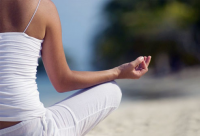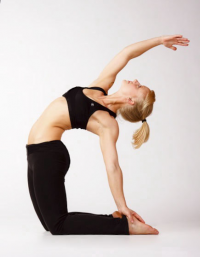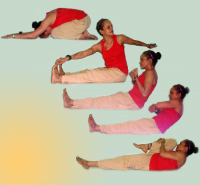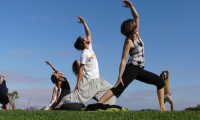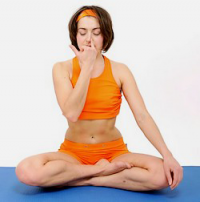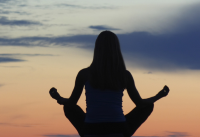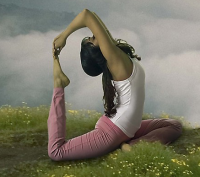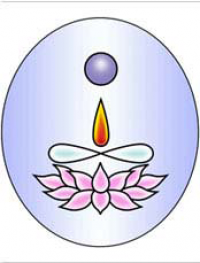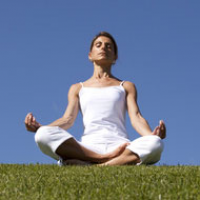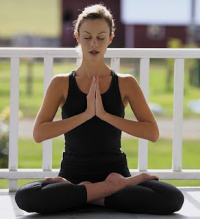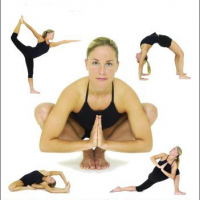Benefits of Adho Mukha Svanasana Adho Mukha Svanasana, Adho Mukha Svanasana Yoga, Adho Mukha Svanasana Benifits: The name comes from the Sanskrit words, adho which means downward, mukha which means face, svana which means dog and asana meaning pose. Adho Mukha Svanasana helps in building power, flexibility and alertness. * Adho Mukha Svanasana helps to strengthen the immune system. * Adho Mukha Svanasana helps to relieve the symptoms of menopause. * Adho Mukha Svanasana builds strength throughout the body. * Adho Mukha Svanasana also provides an overall body stretch. * Adho Mukha Svanasanahelps in relieving fatigue and gives freshness to the body. * Adho Mukha Svanasana relieves some headaches and insomnia. * Adho Mukha Svanasanais a great preparation for standing poses. * It calms the mind and lifts the spirits. * It also improves digestion. * It strengthens arms, legs, and feet. * It stretches the shoulders, legs, and spine. * It helps back to be less stiff. * Adho Mukha Svanasanalessens stiffness in heels and legs. * It helps to open up the shoulder blades. * It stretches the back of the body, especially hips and hamstrings. * It is helpful in increasing blood flow. * Adho Mukha Svanasanamay relieve menstrual discomfort, but make sure that in this head should be supported. * It is helpful in preventing osteoporosis * It may be useful in chest opening. * It is recommended for people suffering from high blood pressure, asthma, flat feet, sciatica, sinusitis, etc.
Personal Values Benefits Yoga * Along with a host of benefits, Yoga also helps in developing and attaining personal values. Yoga erases a variety of ills in human beings. These may range from feelings of frustration, persecution and insecurity. Yoga greatly helps in the development of personal values. * Personal values are those values which an individual develops and lives by all through his life. The main aim of life is to enjoy every moment and Yoga indeed plays a vital role in this regard. Yoga makes life better. Yoga is a continuing process and a life long thing, not just something you do for a while and stop. We all strive for improvement throughout our lives. It is an indication of our resolve to improve and remain fit. Yoga helps us to attain these goals. * Our body is the vehicle that carries our mind. It is here that Yoga assumes great significance. Personal Values are very important as they define your character and they develop your personality. Your personality is the way others see you. There is a golden rule in this regard- if you don't respect yourself, no-one else will. * So you have to earn that respect from others, not just by words but actions too. Yoga also helps you in your resolve to be better. Remember, your personal values are the foundation of your life; you have to continuously grow them up and nurture. Grow and develop them for entire life.
Pranayamam Sarvaroganivarini ప్రాణాయామం సర్వరోగనివారిణి యోగా ఈనాటిది కాదు. అతి ప్రాచీనకాలంలో మహర్షులు ఆచరించి అద్భుతాలు సాధించారు. అయితే యోగసాధన మరుగున పడిపోయింది. దీనికి రావలసినంత ఖ్యాతి రాలేదు. అందుబాటులో ఉన్న అమూల్యమైన ధనాన్ని వెచ్చించడం చేతగాక పక్కన పడేశాం. కొంత ఆశాజనకమైన మార్పు ఏమిటంటే కొన్నేళ్లుగా యోగా గొప్పతనం కొందరికైనా తెలిసివచ్చింది. యోగా మహత్తు తెలిసిన కొందరు యోగాసనాలు ప్రాక్టీసు చేస్తున్నారు. యోగా భంగిమలు, ఆసనాలు చేసే మేలు గ్రహించి తమకు అనుకూలమైన ఆసనాలను ఎంచుకుని సాధన చేస్తున్నారు. సత్ఫలితాలను పొందుతున్నారు. కాళ్ళు, చేతులు, నడుము, వెన్నెముక, భుజాలు, పాదాలు - ఇలా మన శరీరంలో ప్రతి భాగాన్నీ బలంగా, దృఢంగా, ఆరోగ్యంగా రూపొందించుకుంటున్నారు. వివిధ ఆసనాల సంగతి అలా ఉంచితే శ్వాస (బ్రీతింగ్ టెక్నిక్) చాలా ముఖ్యమైంది. ఇది ఒకరకంగా ధ్యానం. శ్వాసకోశాల నిండా ఊపిరి తీసుకుని, పూర్తిగా విడిస్తే చాలు దివ్య ఔషధంలా పనిచేస్తుంది. ఇది సర్వరోగనివారిణి అంటే అతిశయోక్తి కాదు. రోజూ ప్రాణాయామం చేసేవారికి అసలు జబ్బులనేవి దరిదాపులకు రావని ఎందరో యోగా సాధకులు స్వానుభవంతో చెప్తున్నారు. యోగా ఆరోగ్యాన్ని చేకూర్చడమే కాదు, ఆనందాన్నీ ఇస్తుంది. ధ్యానంతో మనసు, శరీరం రిలాక్స్ అవుతాయి. అలసట, శ్రమ, ఒత్తిడి తెలీవు. ప్రశాంతత సొంతమౌతుంది. రక్తం శుద్ధి అవుతుంది. రక్తప్రసరణ నియంత్రణలో ఉంటుంది.
Benefits Of Dharana The word Dharana means both the practice of deep concentration and it also is the state of being in which you attain deep concentration. Ideally, dharana should be performed at every moment of the day. It’s synonymous with the adage “being in the moment” Dharana is a form of meditation that can be called receptive concentration. With the help of Dharana, a set of conditions are created that helps the mind focus in one direction and object, rather than concentrating in many directions, thereby diverting the mind. The term 'Dharana' is given to both the practice of deep concentration and the state in which you achieve deep concentration. Ideally, 'Dharana' should be performed at every moment of the day to gain utmost control of both body and mind. * Dharana aims at setting up the mind, by focusing it upon some stable entity. One good method to start it is by rolling the eyes upward and downward, in one direction to get the concentration. Any object selected for practicing has no role to play in the meditation process. * The object is only used to stop the mind from wandering - through memories, dreams, or reflective thought - by intentionally holding it obsessively upon some static object. This ability is a movement toward perception of its true nature and not an escape from reality. * Dharana helps in channeling one's thoughts on a certain thing. It makes sure that you reach a level of awareness in anything you do, by focusing on every step you take. Dharana can bring richness to one's life. With the help of deep contemplation and reflection, one can create the right conditions. * Dharana works with the objective to achieve the mental state, where the mind, intellect, and ego are controlled. The mind becomes purified by the practices. It becomes able to focus efficiently on one subject or point of experience. Dharana also helps in the cessation of fluctuations in the mind. * The practice of Dharana, at the time, when you are struggling with anger, restlessness or expectation would help in balancing those struggles. Dharana is the practice of training the mind, to concentrate and focus, in such a way, that we can possibly avoid frustrations. * Concentrating our attention on one point allows the mind to be stable and calms the disturbance of activity, to which we are used to. The point of concentration can be anywhere within our body or outside. Therefore, maintaining a fixed and focused concentration, throughout the practice, gives consistency and clarity to the thoughts.
Yoga Poses to Improve Your Digestion * The most soothing practice, in yoga, for healing digestive disasters, including inflammatory conditions, however is the passive practice of meditation. A ten-minute meditation, lying supine in the corpse pose (shavasana) or as in the crocodile pose will be the best therapy. * You may however have to avoid them when there is an inflammatory condition like ulcer or any perforated condition of the digestive tract.a gentle yoga practice when you have a digestive problem will soothe the stomach. Even where poses are suggested that apply pressure on the abdomen, care must be taken not to press down into them, but to hold the poses. * Having a regular meal schedule, giving sufficient gap between eating and exercising/or sleeping, waking up early, eating dinner early, are some simple tips to maintain a healthy gut. lightly.
Women in Yoga in the West Yoga has now become a very popular activity in the west from last few decades. Very famous Hollywood artists confess their love and passion for this art. Basically, yoga came in contact with the west during the times of Plato and Aristotle who paid ample acknowledgments to Indian values in their arts. * These contacts were furthered by Alexander's arrival in India in the third century B.C. The formation of Asiatic Society quite later boosted up the concept of Indian mysticism in west which also included the wonders of yoga. The Yoga was formally introduced in the west through Sanskrit to English or Hindi to English translations of Indian epics. * Modern Yoga gained momentum in the west after late 1800's after the famous disciples of Swami Vivekananda and other great gurus traveled to west and came in contact of the people of west who also inclined towards this art. Germans were the first people to explore the beauty of the Sanskrit language and Vedic mystery. * Scholars like Max Mull immensely contributed in making Indian philosophy popular in west. With time several yoga masters went to west from India and brought popularity to this art in the west. Hatha Yoga then became the most popular form of Yoga in the west. * The Hatha Yoga has derived its meaning from 'Ha' of Sun and 'tha' of moon. It is popularly called forceful yoga because it seems to require all the physical exercises of yoga popularly known. It is said to be very balancing form of yoga aimed to balance to opposite forces in the body. * The entire art of Hatha yoga is based on basic features of yoga, breathing techniques, postures and energizing the subtle channels. It also aims to increase concentration and balance the energy level in the body.
Benefits Of Yoga For Pregnant Women Yoga is an ancient Indian form of exercise with an holistic approach, meaning it tackles a person's well being as a whole - mind and body - unlike other forms of exercise. Yoga can help women get through their pregnancy with minimal discomfort. It also helps the birth and post-delivery stages. * Yoga improves the blood circulation and minimizes the problems of water retention and edema. * Yoga reduces the anxiety and stress and induces a relaxing sleep. It helps women adapt to the new situations. * It successfully expels toxins from the body and improves digestion. * Yoga is a safe way for strengthening muscles and joints. * It regulates blood pressure and sugar levels in body and thus helps in preventing the risk of getting diabetes and high blood pressure during pregnancy. * Yoga stimulates the nerves and calms the body and mind. Breathing exercises regulate the hormones and emotions. * Yoga improves the posture and thus helps in easing back problems which are common in most of the pregnant women. * Regular practice of yoga stretches many ligaments throughout the pelvic, hip and leg areas, which eases labor pain. * Breathing exercises reduce mood swings, nausea and morning sickness. * Yoga strengthens the abdominal muscles which take part in pushing the baby through the birth canal.
Yoga Breathing or Pranayama The power of breathing practice to change your state of mind is extremely strong. A breathing practice can last anything from two minutes to half an hour or more. * Find a quiet place where you won't be distracted. If doing the exercises inside, make sure the window is open to allow plenty of fresh air into the room. * At first practise pranayama lying down and then gradually aim to sit upright with your spine straight. * Breathe evenly through the nose throughout the postures. * Never strain your breathing in pranayama. * Breathe deeply and slowly. * Progress slowly and carefully. * If you feel dizzy or light-headed, return to normal breathing. * Ask a friend to stay with you when trying out a new technique. * Do not rush things and practice all exercises as slowly as you can.
The Meaning Of Meditation Meaning Meditation, Definition Meditation, Yoga Meditation: Meaning of meditation. What does meditation mean? Information and translations of meditation in the telugu.
Yoga For Meditation Yoga precedes meditation. Any physical activity preceding meditation helps for thoughts to subside. Yoga is an excellent aid to get into meditation. * Padmasana (Lotus Pose) Padmasana is one of the most popular poses for meditation. This asans apart from being a meditative pose, removes stiffness from the knees, improves posture and calms the mind. * Vajrasana (Thunderbolt pose) Vajrasana or the 'Thunderbolt pose' is also one of the poses for meditation. Vajrasana speeds up digestion, makes ankle joints flexible, improves the body posture, beneficial for the reproductive organs as well. * Sukhasana (Easy pose) Sukhasana is the simple way of sitting with the legs crossed. This asana falls in the category of Yoga for meditation. This is one of the most simple asanas and the usual way of an Indian sitting on the floor. This asana is beneficial for the hips and the spine. It brings in an inner calm, banishing anxiety. * Siddhasana is also a simple meditative pose. It purifies the 72,000 channels in the human body through which energy passes) It is beneficial for the knees and the ankles, lower spine, pubic region, abdominal organs etc. It renders calmness of the mind
Yoga Back Bender Yoga back bender has two different curves on each side a steady arch at one end and a steep arch on the other end. The steep arch is meant for yoga practitioners who are more flexible. * It helps to open the front body, shoulders and chest. * It provides support for quieter restorative practice. * It helps in supporting back, which otherwise gets hurt. * Besides, it also enhances the final relaxation poses. * Forward Bender Forward bender is helpful to perform difficult forward bends. It is a triangle shaped prop with several open slots along its curvature that looks like a curved ladder. It extends forward stretch into the calf muscles, so that the spine is fully expanded and straightened. Forward bender can be used for 1 and 2-legged forward bends. It effectively stretches hamstrings, calf muscles and achilles tendons. * Whale Back Bender Whale back bender is a popular back bender among people. It's wide enough to support your entire back, while offering comfort to your spine as you perform a stretch. It looks like the regular back bender, but actually it is much broader than the regular ones. It helps in tractioning your spine without stressing other joints. * Foldaway Back Bender As the name suggests, Foldaway Back Bender is a prop that can be folded, or can be separated to make two new props. It can be used to practice drop-backs and forward bends. It occupies less storage space, making itself the most versatile and innovative back bench.
Benefits of Rajyoga Raja Yoga, sometimes called the "Royal Yoga" is inclusive of all yogas, and its philosophy goes beyond the boundaries of the many styles of yoga today. Raja Yoga is also referred to as the Mental Yoga, or the Yoga of the Mind, because of its emphasis on awareness of one's state of mind. It is through this practice of concentration that one learns to calm the mind and bring it to one point of focus. It is at this point that we direct our attention inwardly, toward our true nature, which is Divine. You can achieve this by following the Eight-Fold Path of Raja Yoga, which includes observation of the following: * Yamas (Abstentions): Ahimsa (non-injury), Satya (truth), Asetya (non-stealing), Brahmacharya (chastity), Apragraha (non-greed) * Niyamas (Moral Observations): Susha (purity), Santosha (contentment), Tapas (austerity), Svadhaya (study of the scriptures), Ishvara Pranidhana (surrender to God) * Asana: Steady pose, posture or seat * Pranayama: control of vital energy through breathwork * Pratyahara: Withdrawal of the senses * Dharana: concentration of the mind * Dhyana: Meditation * Samadhi: Enlightenment, union with the Divine
Yoga For Great Hair Yoga for good hair growth there are many yoga asanas which are proved to be beneficial for hair growth. Did you know that Yoga is good for your hair? Yes from Yoga you can get lots of good benefits and have a great mind and body. You can start with some breathing exercises to keep your hair in perfect condition. Taking care of your hair is equally important as you do Yoga along with it. Some beauty regimen and good diet is important for you to have your hair in great shape. Digestive imbalance and hormonal misbalance can create problems in your body system as well as have affects on your mental health. Proper blood circulation is good for your scalp and keeps your hair good and luscious. Some asanas which keeps your blood circulation in head in proper condition are as follows: Sirsasana, Sarvanasana, and Ustrasana. But you should take expert advice to do these asanas properly.
Purna Yoga Benefits Purna Yoga Benefits, Purna Yoga Poses, Purna Yoga: Purna Yoga gives Yoga a positive and dynamic form. It suggests three levels of integration- the integration of the inner, the integration of the human psyche with its external environment and the integration of the psyche with its ultimate spiritual Ground. It not just brings optimism and positive energies to the body but also to the world at large. It is this united spirituality that proficiently combines self-transcendence with love, sympathy, and reverence for all living beings. It puts together the varied aspects of yoga, needed for transformation and healing. * Many of us have different activities that we practice in order to promote good health. To get stronger we may lift weights, for cardiovascular exercise we may do an aerobic activity, for balance and harmony we may use tai-chi, for flexibility we stretch out and meditation to find peace of mind and relax. • Does it all- It supports the mind, body, emotions and your Spirit • It creates both strength and flexibility • Promotes good cardiovascular health • Helps to create mental clarity and will relieve stress • Will create an emotional balance • Connects you awareness to your intuition and wisdom within • This style is safe for all ages and body types • Promotes healing from injuries • Promotes an overall sense of wellness. * Purna Yoga Benefits Purna Yoga is the style of yoga which teaches alignment-based asana, healthy living and heart-centered meditation to help people achieve a wholeness, fulfillment and healing to life’s purpose. Purna yoga teacher training creates a way to have a life changing experience and through practice meeting the needs of today’s world.
Mantra Yoga Benefits Mantra Yoga Postures , MantraYoga Poses, Types of Mantra Yoga: Different people use different mantras for chanting. The mantras could be a particular sentence or a group of sentences related to a particular spiritual meaning. The most commonly used word for chanting is ‘Om’ which according to Sanskrit means spirit and according to hindu mythology it means emptiness. The combination of the two derives the purpose of the mantra yoga – A calm spirit detached from the anxieties and worries of a regular life. * Mantra yoga works a great deal on people suffering from anxiety, stress , nervousness, panic attacks and fear, * Regular chanting of the mantras creates a sense of tranquillity. * It also helps achieve inner peace * The advantage of mantra yoga, as it is believed, is that it turns an unhappy person into a happy and serene individual. * Since the most commonly chanted word is the word ‘Om’, the repetition of this word creates a physical vibration along with the mental one. This leads the practitioner to lead levels of sub and super consciousness. * Helps focus on your inner self. * It has positive effects on the nervous system. * This yoga relaxes the mind, body and the soul. * Mantra yoga when practiced to extreme levels, helps attain intense points of concentration that can cure any physical or mental disorders. * A person practicing mantra yoga benefits from regulated breath and clarity of mind. * The spiritual benefits of this yoga are psychic intervention, control of ones own mind and thoughts. * The relaxation of the mind enhances knowledge and the pressures of life are controlled by the thought control process. * The most important and ultimate benefit of mantra yoga is self realization and leads an individual on the road to enlightenment.
Karma Yoga Benefits Karma is a Sanskrit term meaning action or deed, either physical or mental. Thinking constitutes an act of mental Karma and all Karma is the sum total of an individual’s acts, in the present life and in past incarnations. Karma does not just refer to action; it also the result of our actions. There is a latent power in Karma or action. This is called 'Adrishta'. It is that which brings in fruits of karmas to an individual. * Through s service one mages to purify one’s heart. Egoism, hatred, jealousy, feelings of superiority and all the kindred negative traits will disappear. * The Karma Yogi develops feelings of humility, pure love, sympathy, tolerance and mercy. Above all that sense of separateness from the Almighty gets obliterated. Selfishness is removed. The practitioner develops a tolerant and broadminded outlook to life. * Karma takes the shape of Karma Yoga, when the practitioner acts as an instrument in the hands of the Almighty, as a participant in the cosmic activity of Nature and does the service without the expectation of fruits. The person then believes that he/she is only the instrument and that the Lord is working unselfishly, through him/her. * A person aspiring to follow the divine path of Karma Yoga doesn't have to possess materialistic wealth. All the person needs is a peaceful mind, body and a selfless attitude, to serve humanity. * The person following the path of Karma Yoga, known as Karma Yogi, should be free from lust, greed, egoism and anger. His/her heart should be filled with the thought of serving the poor and the helpless people, selflessly. * Even if the person has any traces of these 'doshas', he/she should try to eliminate them immediately. In addition, he/she should not desire for name, fame or money in return of the service. * he person, who expects respect and honor from others, cannot serve people selflessly. Moreover, a Karma Yogi should be fearless. He/she should be amiable and social. * He / she start to feel a Oneness and Unity with all of creation. Ultimately, the individual gains knowledge of the Self and comes to comprehend the concept of “One in all and All in one."
Jnana Yoga Benefits Jnana yoga is not a new fangled concept in the world of yoga. You can trace down the existence of this practice to the Vedic ages and the age of Bhagavad Gita. Hindu Lord Shri Krishna is believed to be the pioneering proponent of jnana yoga in the ancient age. However, the same practice has been modified and altered with the passing ages. Nevertheless, the flavor and the objective of this yoga have not faded over time and jnana yoga is still considered to be the path toward enlightenment. Practicing Jnana Yoga: * First and foremost read the Hindu ancient holy texts like the Vedas, Bhagavad Gita. * “I am” should be your mantra for chanting. * Focus on “I”. * Next form all sentences that come to your mind when you say I. * Now leave “I” behind and fight your ego to get hold of your focus away from I. * Meditate and breathe deep. * Discuss with your guru Benefits of Jnana Yoga Jnana yoga is awareness, not realization. Jnana Yoga is the understanding of the laws of existence and the awareness of a means to synchronize with them. In Jnana Yoga one ceases to be attached to forms of expression and becomes drawn to the essence, the process of insight.
Hatha Yoga Benefits Health Benefits Hatha Yoga, Hatha Yoga Health Benefits, Hatha Yoga: Many Eastern cultures believe that there is a strong connection between the body and the mind, and when these energies become imbalanced, it is thought that people can be left susceptible to illness, injury, and disease. Yoga strives to connect the two through physical positions (asanas) and breathing exercises. Some of the many hatha yoga benefits that are believed to come from this practice include: * Improved physical health * Stress relief * Improved balance * Increased strength * Poise * Detoxification * Flexibility While there are many hatha yoga benefits, it is still important to consult with your primary care provider before you begin any new alternative therapy, including this practice. Most people are able to enjoy these great benefits with no problem, but getting a second opinion from your doctor to ensure you avoid injury or complications is never a bad idea.


